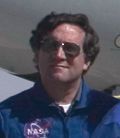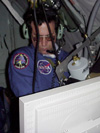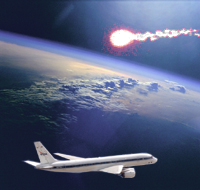
 Dr. George S. Rossano,
Dr. George S. Rossano,
Aerospace Corporation
E-Mail:
Homepage
Brief Biographical Information:
Mathematician and Physicist Rossano is a member of the Remote Sensing Department of The Aerospace Corporation at El Segundo, CA, where he developed and built a new slit-less mid-Infrared spectrograph MIRIS.
Rossano is also a judge of professional ice skating and is editor of the on-line journal on competitive ice skating.
Research:
Instrument development. 3-5.5 micron Mid-IR spectroscopy.
 Research on Leonid MAC:
Research on Leonid MAC:
During the 1998 Leonid MAC, the first two detections of meteors in the 3-5.5 micron
wavelength range were obtained with our MIRIS spectrometer, which was operated onboard
FISTA.
More information here.
During the 1999 Leonid MAC, the first mid-IR spectrum of a persistent train was obtained,
showing emission features of C-H stretch vibration band and molecular CO emission.
More information here.
Further persistent train observations were made during the 2002 campaign.
Research on Hyperseed MAC:
3-5.5 micron spectroscopy of the SRC forebody and wake. This work is executed with support of The Aerospace Corporation - Center for Orbital and Reentry Debris Studies.
Publications:
Rossano, G.S., Russell, R.W., Lynch, D.K., Tessensohn, T.K., Warren, D., Jenniskens, P., "Observations of Leonid Meteors Using a Mid-Wave Infrared Imaging Spectrograph," Earth, Moon, and Planets, vol 82-83, p. 81-92, (2000).
Russell, R.W., Rossano, G. S., Chatelain, M.A., Lynch, D.K., Tessensohn, T.K., Abendroth, E., Kim, D.L., Jenniskens, P.,"Mid-Infrared Spectroscopy of Persistent Leonid Trains," Earth, Moon, and Planets, vol 82-83, p. 439-456, (2000).











 Dr. George S. Rossano,
Dr. George S. Rossano,  Research on Leonid MAC:
Research on Leonid MAC: